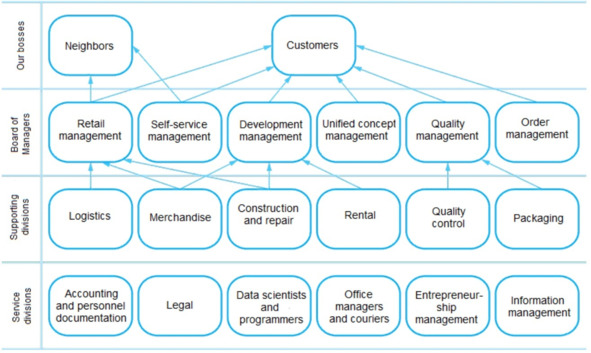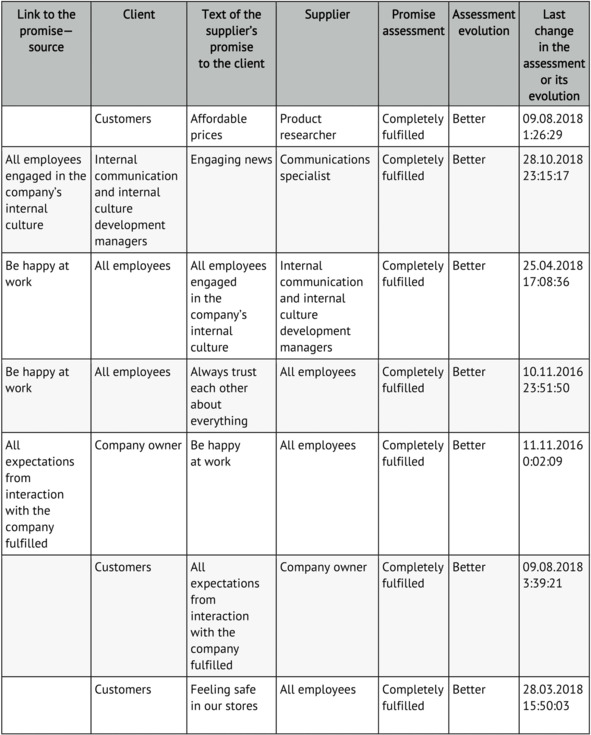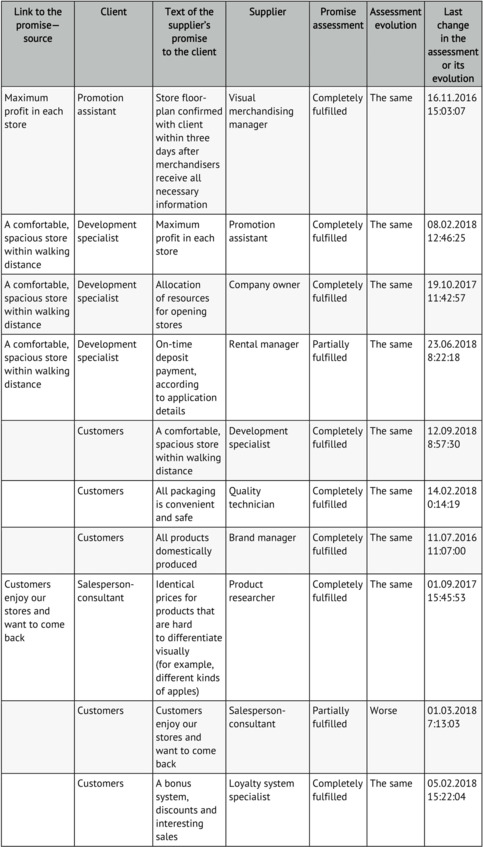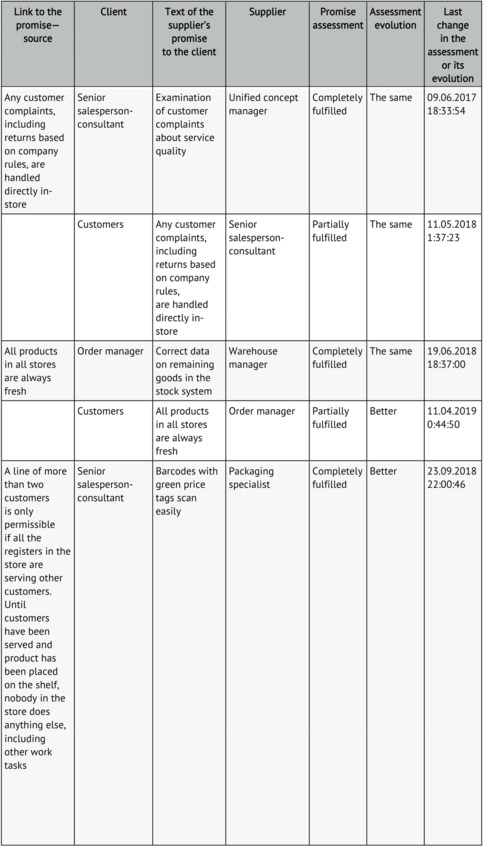
Полная версия
50 shades of teal management: practical cases
1. A client can only ask a supplier for a promise in order to fulfill one of their own, aside from the so-called core promises that companies give their clients.
2. A promise is always a result that can be separated from the supplier.
3. Identical promises cannot fulfill different roles. If there are two consecutive or successive promises, one of them has to be given directly; if there are two parallel promises, then you have to understand who is responsible for what, and each supplier can only promise their part.
4. You can’t create “loops”: I promise you something in order for you to fulfill the promise that you’ve made to me so that I can fulfill my responsibilities to you. In these situations, you should use conditional promises. For example, instead of creating a counter-promise, such as “Our division will only submit correctly completed invoices to accounting so that they can fulfill their promise to us to pay them,” we would create a single promise: “All correctly completed invoices submitted to accounting will be paid within one business day.”
5. A supplier should receive all the rights they need for a given promise.
The fourth bullet point demands additional explanation. If employees can’t make promises to each other, that means that in any partnership, one of them will only be a client and the other will only be a supplier. Somebody might see discrimination in that. I would respond immediately that teal management is by no means about equality for all, but about prioritizing what’s actually important. Others might see the potential for serious conflict between the divisions that we want to reconcile. I’ll jump in to dispel their concerns: there’s a clear logic to who becomes the client and who becomes the supplier. It’s protected in the first bullet point of the list above. But here’s a question: if a client can only ask for a promise from their supplier in order to fulfill a promise of their own, then where do the initial promises come from in the first place? From the company’s promises to their clients. These are what we call the "core promises," and all other promises within the company only appear in order to fulfill them.

This is a diagram of the key promises we make to VkusVill. The promise arrows coming from the service departments are not drawn, as they go to all other structures and divisions within the company.
Special terminology
You probably have a couple of questions: who are these "neighbors" bossing us around alongside our customers? And what is this mysterious "self-service," with a whole division dedicated to it?
I’ll go in order: at VkusVill, the notion of "neighbors" is an established term that we use to talk about people who live near our stores. These people might not be our customers at all, but that doesn’t relieve us of any responsibility; therefore, we promise them that our stores won’t ruin their quality of life. For example, if our store’s exhaust fan is located under their window, then we will install sound deadening, or even pay for him to install double-glazed windows. As you can see in the table, our retail and self-service (I’ll explain what this word means in a bit) divisions make these promises to our neighbors: they’re the ones who think through all of these nuances since they’re the ones who work with the operation of each store location. There were even cases when employees of the aforementioned divisions had to spend nights with these very same "neighbors" to ascertain just how serious the noise from our store was during the hours when they insisted that the street would grow quiet and the noise became noticeable.
"Self-service" refers to stores that consist of a simple refrigerator, shelf and register: people walk up, take what they need, and ring themselves out. We don’t have any employees nearby at all – they only come by in the morning to stock the shelves with fresh products and then leave. Everything else is based on trust. Today, there are more than two hundred of these self-service locations in offices of various Moscow companies.
Okay, the promises have been made. Now all that’s left is to create a unified summary table in our accounting system to store them.
This is roughly how such a table should look.




Assessments are made based on a scale with three options:
• Completely fulfilled;
• Partially fulfilled;
• Not fulfilled.
This assessment should be completely subjective – there is no need to add any sort of numerical proof. The client themselves knows how satisfied they are with the fulfillment of the promise. The only exceptions are the core promises to our customers, which are rarely 100% fulfilled. For such promises, the marketing department usually makes assessments, as they constantly monitor customer satisfaction with what the company has to offer based on indicators that are important to them, then goes on to formulate these promises by positioning the company on the market in a particular way.
In order to monitor how the supplier has processed the client’s comments, you only need three options for the evolution of their assessments:
• better;
• The same;
• worst.
The cherry on top is a system whereby clients and suppliers receive automatic notifications by email about all changes in promise status, assessment and evolution, as well as monitoring of promises that have not been fulfilled for a long time, or that have been in the process of being fulfilled for a long time. The first function is necessary to remind suppliers of the existence of the problem or clients of the need to change their assessment, while the second lets them remove outdated promises that have already fulfilled their purpose or are no longer necessary and are only cluttering the table at this point. In fact, all promises whose source promise has lost its relevance should become outdated automatically, which all interested parties will find out about thanks to automatic email notifications.
Task 7
Analyze several of your orders with these definitions in mind: are they promises or assignments? At the end of the day, who takes responsibility for their fulfillment?
Who’s to blame?
Do you remember the King from Antoine de Saint-Exupéry’s "The Little Prince?" In spite of his pride, this monarch was wise enough not to give the Sun an order to set early. He understood clearly who would carry responsibility in that case, asking logically: "If I ordered a general to fly from one flower to another like a butterfly and if the general did not carry out the order that he had received, which one of us would be in the wrong? […] The general, or myself?”
Additionally, I am often asked for some reason about the number of promises per employee and setting timelines for their fulfillment. I’ll answer once and for all: the number of promises isn’t limited at all. If someone is ready to take on new promises and fulfill them all, then why not? Time limits can be set in principle, but to be honest, the teal management system does not have a good relationship to fixed deadlines, and coming to an agreement over every single sneeze is unreasonable. That’s why we usually make an "eternal" promise, such as "The floor is always clean," and all related time-sensitive measures are put in place within the framework of fulfilling this original promise, without creating any new ones.
Deadlines
Have you yet to figure out that deadlines are almost always set with a many-fold amount of time in reserve? Having estimated that it will take a day at most to execute a task, a supplier will announce that they’ll deliver it in a week – or two! And yet rarely are tasks completed ahead of time. What’s worse, even these inflated deadlines are often broken! Setting deadlines has the opposite effect, relaxing workers and usually resulting in a slowdown of the work process rather than its acceleration, as strange as that may sound. The reason here is not laziness or inability to plan one’s time. Each employee simply has a lot to do, and the question for them isn’t whether or not to do something, but what to do first. Of course, there are always more tasks than time to do them.
Конец ознакомительного фрагмента.
Текст предоставлен ООО «ЛитРес».
Прочитайте эту книгу целиком, купив полную легальную версию на ЛитРес.
Безопасно оплатить книгу можно банковской картой Visa, MasterCard, Maestro, со счета мобильного телефона, с платежного терминала, в салоне МТС или Связной, через PayPal, WebMoney, Яндекс.Деньги, QIWI Кошелек, бонусными картами или другим удобным Вам способом.

